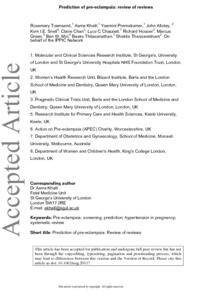Townsend, R;
Khalil, A;
Premakumar, Y;
Allotey, J;
Snell, KIE;
Chan, C;
Chappell, LC;
Hooper, R;
Green, M;
Mol, BW;
et al.
Townsend, R; Khalil, A; Premakumar, Y; Allotey, J; Snell, KIE; Chan, C; Chappell, LC; Hooper, R; Green, M; Mol, BW; Thilaganathan, B; Thangaratinam, S; IPPIC Network
(2019)
Prediction of pre-eclampsia: review of reviews.
Ultrasound Obstet Gynecol, 54 (1).
pp. 16-27.
ISSN 1469-0705
https://doi.org/10.1002/uog.20117
SGUL Authors: Thilaganathan, Baskaran Khalil, Asma
![[img]](https://openaccess.sgul.ac.uk/110258/6.hassmallThumbnailVersion/Townsend_et_al-2018-Ultrasound_in_Obstetrics_%2526_Gynecology.pdf)  Preview |
|
PDF
Accepted Version
Available under License ["licenses_description_publisher" not defined].
Download (3MB)
| Preview
|
Abstract
OBJECTIVE: Primary studies and systematic reviews provide estimates of varying accuracy for different factors in the prediction of pre-eclampsia. The aim of this study was to review published systematic reviews to collate evidence on the ability of available tests to predict pre-eclampsia, to identify high-value avenues for future research and to minimize future research waste in this field. METHODS: MEDLINE, EMBASE and The Cochrane Library including DARE (Database of Abstracts of Reviews of Effects) databases, from database inception to March 2017, and bibliographies of relevant articles were searched, without language restrictions, for systematic reviews and meta-analyses on the prediction of pre-eclampsia. The quality of the included reviews was assessed using the AMSTAR tool and a modified version of the QUIPS tool. We evaluated the comprehensiveness of search, sample size, tests and outcomes evaluated, data synthesis methods, predictive ability estimates, risk of bias related to the population studied, measurement of predictors and outcomes, study attrition and adjustment for confounding. RESULTS: From 2444 citations identified, 126 reviews were included, reporting on over 90 predictors and 52 prediction models for pre-eclampsia. Around a third (n = 37 (29.4%)) of all reviews investigated solely biochemical markers for predicting pre-eclampsia, 31 (24.6%) investigated genetic associations with pre-eclampsia, 46 (36.5%) reported on clinical characteristics, four (3.2%) evaluated only ultrasound markers and six (4.8%) studied a combination of tests; two (1.6%) additional reviews evaluated primary studies investigating any screening test for pre-eclampsia. Reviews included between two and 265 primary studies, including up to 25 356 688 women in the largest review. Only approximately half (n = 67 (53.2%)) of the reviews assessed the quality of the included studies. There was a high risk of bias in many of the included reviews, particularly in relation to population representativeness and study attrition. Over 80% (n = 106 (84.1%)) summarized the findings using meta-analysis. Thirty-two (25.4%) studies lacked a formal statement on funding. The predictors with the best test performance were body mass index (BMI) > 35 kg/m2 , with a specificity of 92% (95% CI, 89-95%) and a sensitivity of 21% (95% CI, 12-31%); BMI > 25 kg/m2 , with a specificity of 73% (95% CI, 64-83%) and a sensitivity of 47% (95% CI, 33-61%); first-trimester uterine artery pulsatility index or resistance index > 90th centile (specificity 93% (95% CI, 90-96%) and sensitivity 26% (95% CI, 23-31%)); placental growth factor (specificity 89% (95% CI, 89-89%) and sensitivity 65% (95% CI, 63-67%)); and placental protein 13 (specificity 88% (95% CI, 87-89%) and sensitivity 37% (95% CI, 33-41%)). No single marker had a test performance suitable for routine clinical use. Models combining markers showed promise, but none had undergone external validation. CONCLUSIONS: This review of reviews calls into question the need for further aggregate meta-analysis in this area given the large number of published reviews subject to the common limitations of primary predictive studies. Prospective, well-designed studies of predictive markers, preferably randomized intervention studies, and combined through individual-patient data meta-analysis are needed to develop and validate new prediction models to facilitate the prediction of pre-eclampsia and minimize further research waste in this field. Copyright © 2018 ISUOG. Published by John Wiley & Sons Ltd.
| Item Type: |
Article
|
| Additional Information: |
This is the peer reviewed version of the following article: Townsend, R. , Khalil, A. , Premakumar, Y. , Allotey, J. , Snell, K. I., Chan, C. , Chappell, L. C., Hooper, R. , Green, M. , Mol, B. W., Thilaganathan, B. , Thangaratinam, S. and , (2019), Prediction of pre‐eclampsia: review of reviews. Ultrasound Obstet Gynecol, 54: 16-27, which has been published in final form at https://doi.org/10.1002/uog.20117. This article may be used for non-commercial purposes in accordance with Wiley Terms and Conditions for Use of Self-Archived Versions. |
| Keywords: |
hypertension in pregnancy, pre-eclampsia, prediction, screening, systematic review, IPPIC Network, Pre-eclampsia, hypertension in pregnancy, prediction, screening, systematic review, 1114 Paediatrics And Reproductive Medicine, Obstetrics & Reproductive Medicine |
| SGUL Research Institute / Research Centre: |
Academic Structure > Molecular and Clinical Sciences Research Institute (MCS) |
| Journal or Publication Title: |
Ultrasound Obstet Gynecol |
| ISSN: |
1469-0705 |
| Language: |
eng |
| Dates: |
| Date | Event |
|---|
| July 2019 | Published | | 9 July 2019 | Published Online | | 26 August 2018 | Accepted |
|
| Publisher License: |
Publisher's own licence |
| Projects: |
|
| PubMed ID: |
30267475 |
 |
Go to PubMed abstract |
| URI: |
https://openaccess.sgul.ac.uk/id/eprint/110258 |
| Publisher's version: |
https://doi.org/10.1002/uog.20117 |
Statistics
Item downloaded times since 02 Aug 2019.
Actions (login required)
 |
Edit Item |



